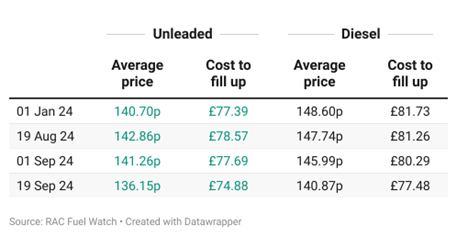Petrol and diesel pump prices have fallen by around 7 pence per litre (ppl) in the past month, with the cost of both fuels set to fall further, according to the RAC.
Pump prices at UK forecourts are now falling more quickly than at any other point so far this year.
As of Thursday (September 19), a litre of unleaded was being sold for 136.15ppl on average – down 5p since the start of September (141.26ppl) and almost 7p lower than a month ago (142.86ppl).
For diesel, the drop is similar with average prices down 5p since the start of the month (145.99ppl) to 140.87ppl, and nearly 7p lower than a month ago (147.74ppl).
The recent sharp reductions mean that both petrol and diesel are now at their cheapest prices in almost three years.

RAC fuel spokesperson Simon Williams said: “It’s really encouraging to see pump prices coming down so rapidly, which we know is as good for drivers’ wallets as it is for keeping the headline level of inflation in check.”
The last time prices were dropping as quickly over the course of a month was between late November and the end of December 2023, when average prices at the pumps for both fuels reduced by more than 7p. However, prices on forecourts were considerably higher than they are today.
Supermarkets are currently charging 133.23ppl for unleaded and 137.69ppl for diesel. In Northern Ireland, where the RAC considers pump prices to be at their fairest, a litre of petrol is just 131.5ppl and diesel 134.2ppl.
The RAC expects average pump prices to fall to a three-year low as soon as the end of September and, if prices continue to drop as the RAC hopes, the average cost of a litre of petrol could dip to as low as 132p and diesel to 138p within the next fortnight. That would be the lowest price drivers have paid for either fuel since July and September 2021, respectively.
Prices have fallen thanks to a relatively low oil price of $73 brought about by lower global demand, combined with a relatively strong pound, with the latter being helped by a fall in the UK’s rate of inflation.
With fuel traded in US dollars, a stronger pound means UK fuel retailers get more ‘bang for their buck’ when buying in new stock on the wholesale market.
Williams said: “Of course, global oil prices and even the strength of the pound can fluctuate wildly and that’s something completely out of drivers’ control. But with the cost of filling up making up a sizeable chunk of many households’ overall monthly spending it makes sense to stretch every pound spent on fuel as far as possible.
“Driving efficiently – for instance, with a ‘light right foot’ and by changing up to as high a gear as possible – is the best way to do this, along with paying less to fill up in the first place.”
Based on wholesale pump prices, which is what retailers pay to buy the fuel in the first place, Williams believes that there is scope for further price cuts.
“We very much hope that within the next few weeks we’ll see pump prices reach their lowest levels in three years,” he continued.
“And, as our analysis clearly shows, it’s drivers in Northern Ireland who continue to get the best value with pump prices there between 5.5p and 6p cheaper per litre compared to the average across the whole of the UK.”
He added: “We continue to look forward to the new Government proceeding with its plans to introduce greater pump price transparency with the Pumpwatch scheme, along with an official monitoring function that can help ensure drivers are charged a fair price every time they fill up.”

























Login to comment
Comments
No comments have been made yet.